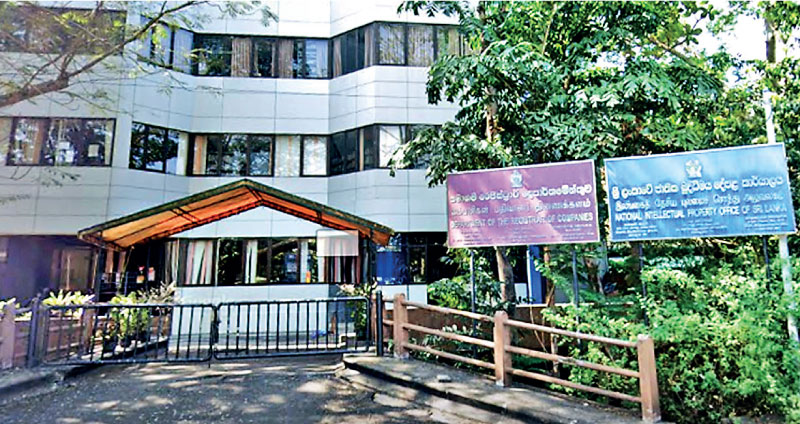Wednesday Dec 31, 2025
Wednesday Dec 31, 2025
Thursday, 26 May 2022 01:15 - - {{hitsCtrl.values.hits}}

|
 A trademark is considered as the identity of a company in modern commerce. In the globalised world, trademarks have become a vital part of business development. Trademarks are used widely to promote brands globally. A trademark is a sign that is used to distinguish one business entity from another business and helps the consumer to distinguish one product or service from the other. Trademarks do not expire, unlike patents or copyrights. Trademarks being an intellectual property (IP) is an intangible asset that can be owned, transferred, sold, or licensed. Even though registering IP assets such as logos and slogans is not a must, it affords protection to the brand.
A trademark is considered as the identity of a company in modern commerce. In the globalised world, trademarks have become a vital part of business development. Trademarks are used widely to promote brands globally. A trademark is a sign that is used to distinguish one business entity from another business and helps the consumer to distinguish one product or service from the other. Trademarks do not expire, unlike patents or copyrights. Trademarks being an intellectual property (IP) is an intangible asset that can be owned, transferred, sold, or licensed. Even though registering IP assets such as logos and slogans is not a must, it affords protection to the brand.
The origins of intellectual property law can be traced back to the British colonial rule in Sri Lanka. British Inventor’s Ordinance of 1859 was the first statutory instrument which afforded protection for intellectual property and accordingly, the first patent was granted on 22 November 1860 under the said Ordinance. Since then, many IP laws have been enacted by the colonial Government – Trademarks Ordinance of 1888, Patents Ordinance of 1906, Design Ordinance of 1904, Copyright Ordinance of 1908. These laws had been in use in Sri Lanka even after the independence in 1948.
The first IP law in independent Sri Lanka was enacted following the introduction of open economic policies in 1977. Hence, with the enactment of the Code of Intellectual Property Act No. 52 of 1979 is considered as the turning point in the modern IP laws in Sri Lanka. Thereafter, the enactment of the Intellectual Property Act No. 36 of 2003 replacing the Act of 1979 has provided the basis of enforcement of trademark registration, control, and administration.
The Act classifies IP under several headings such as copyright and related rights, inventions, industrial designs, trademarks, geographical indications, undisclosed information including trade secrets, protection against unfair competition and layout designs of integrated circuits, etc. Sri Lanka has a unitary system in administering all IP under one umbrella. The National Intellectual Property Office (NIPO) established under the current Act is mandated with the administration of the Intellectual Property system of the country. The decisions of NIPO’s Director-General on IP related matters are final and can only be challenged in a court of law.
Marks are basically of two types: trademarks and service marks. Trademarks relate to goods and service; marks relate to services. Definitions given to trademark may vary from country to country with some countries having expanded trademark law regimes to incorporate a wider range of trademarks. Sri Lankan law simply defines a trademark as ‘any visible sign serving to distinguish the goods of one enterprise from those of another enterprise’. Accordingly, only visible signs can be registered as trademarks in Sri Lanka. This includes a word(s), a symbol(s), a device(s), letters, numerals, a name, surname or geographical name, a combination or arrangement of colours and shapes of goods or containers, etc. ‘Distinguishability’ is a key requirement under Sri Lankan law and inability to distinguish goods will render the trademark inadmissible in registration. Unlike in other jurisdictions, ‘use’ is not a requirement for registering a trademark in Sri Lanka.
Exclusive rights to a trademark can be acquired on registration. Registration at the NIPO affords the owner with an exclusive right to use, license, sell and take legal action to stop others from using a registered trademark. Registration of trademark may be granted to the person who is the first to fulfil the conditions of a valid application or who is the first to validly claim the earliest priority for his application. Although the full protection under the IP Act is granted only to the registered trademarks, the unregistered marks are also afforded protection by the common law of Sri Lanka where action based on the tort of passing off or where an action under the unfair competition law would provide plausible causes of action.
If a trademark is not registered, someone else can steal it and use it eventually, a problem faced by many business owners at some point. The more popular and developed the business becomes, the more the chances of facing this sort of problem. To overcome this problem, the logo of the business should be registered before someone else claims it. Registration may be initiated by any person or body of persons corporate and unincorporated: (i.e., individual(s), companies, partnerships, associations etc.). For the registration, an application should be filed at the NIPO. If the entity applying for the registration is a foreign company, the application should be filed through a local agent. For this purpose, a power of attorney to that effect should be granted by the foreign company to the local agent. Once the application is received, NIPO examines the mark for the formal requirements under Section 106 of the IP Act at first. Then the substantive examination is carried out to see whether the trademark falls within any absolute grounds and/or relative grounds for objections which makes the trademark unqualified for registration. In performing the substantive examination ‘the similarity test/search’ is carried out using the national database and the World Intellectual Property Organisation (WIPO) brand database. If NIPO refuses the registration, the applicant can appeal the decision in the Commercial High Court of Colombo within one month from the date of refusal. If NIPO accepts the registration, it will be published in the Gazette and a period of three months will be given to the public after the publication to file an opposition. In case of an opposition, NIPO will hold an inquiry on which basis the trademark may either be accepted or refused. After the acceptance, registration will proceed upon the payment of the registration fee by the applicant. The registration is valid for a period of 10 years and renewable on the payment of the fee prescribed by NIPO.
A trademark has earned its worth all due to its functionality. The basic function is to distinguish the goods of its owner from those of others. Trademark designate the source of the goods and individualise them. It also allows the owner to access the customers and also assists the consumer in making a choice in the market. In case of infringement of owners’ rights, an owner can enforce the rights at criminal or civil courts for damages due to the fact that a registered trademark owner is the absolute owner and has exclusive rights over it. Besides, the owner can prevent others from using it or any deceptive resembling mark. As already mentioned, a trademark is a registered asset of a company, and hence it can be sold or licenced to a third party for a fee.
A brand represents a company’s reputation, and a trademark legally protects those aspects of the brand specific to the company. With the development of the business, the value of the trademark goes up and it becomes of great monetary value. For example, the trademark ‘Apple’ is currently (2021) worth about $ 263 billion and the value of the trademark is one eighth of the company’s market capitalisation. Most valuable and noted Sri Lankan brands in 2021 are Dialog, Bank of Ceylon, and People’s Bank. Another advantage of a trademark is that it can prevent imported pirated goods from getting into the country. The Director-General of Customs has the power to impose a penalty and destroy and dispose of such goods.
|
Sri Lanka has been part of the global initiatives of trademarks. Sri Lanka became a member of the World Intellectual Property Organisation (WIPO) in the year of 1978. Furthermore, Sri Lanka acceded international treaties such as the Madrid Agreement in 1952, Berne Convention in 1959, Paris Convention in 1952, Patent Cooperation Treaty in 1981, Agreement on Trade-Related Aspects of Intellectual Property Rights (TRIPS) in 1994, Trademark Law Treaty in 1996 etc.
There are several issues associated with the present trademark law in force in Sri Lanka. The urgency for attending to them may vary with the economic progress of the country. The legal framework at present does not provide protection in another country for the locally registered trademarks. In cases where the applicant is engaged in business in a foreign country, it is advisable to apply for the registration of the trademark under the law in that country. The best remedy for this issue is to become a member of the Madrid Protocol. If a country accedes to the Madrid Protocol, it allows an applicant in a member country to file a single application with a prescribed fee for the registration of a trademark up to 125 countries. This will benefit the business community because filling specific applications in each foreign country can be avoided accordingly. The Government has taken steps to accede to the Madrid Protocol last year having obtained the Cabinet approval to this effect on 12 February 2020. Hopefully, this will take effect with the new amendments to the Intellectual Property Act of 2003.
NIPO follows the 11th edition of the Nice Classification (NCL) which is an international classification of goods and services applied for the registration of marks even though Sri Lanka is not a party to the Nice Agreement of 1957 and accordingly, registration of marks is acceptable in classes 1-34 (goods) and 35-45 (services). Even though Nice Classification provides for Horn, bone, ivory, whalebone under Class 20 and game, edible birds under Class 29 they are prohibited in Sri Lanka. A trademark can generally be filed either as a single-class application or a multi-class application. NIPO accepts only single-class applications for registrations. Multi-class applications cover several classes in a single application while single-class applications allow only one mark per application. In some circumstances, multi-class applications can be more cost-effective and it is easier to administer the trademark portfolio. However, it should be noted that there are pros and cons in both of these application methods. Nevertheless, NIPO should facilitate both types of application processes affording a choice to the applicant to select between, fitting to one’s suitability as this mostly depends on the circumstances and requirements.
Under the current Act, only a visible sign can be registered as a trademark which means that the scope is limited to traditional trademarks alone. The non-traditional Trademarks (NTTM) are not eligible for registration as they do not fall within the requirements given in the Act. The non-traditional trademarks are somewhat new to the arena and they comprise single colours, smells, shapes, videos, touch, textures, moving images and holograms, etc. NTTMs such as sound, taste, touch, texture can be considered as non-visual signs that cannot be registered under the current law. Article 15.1 of TRIPS to which Sri Lanka is a party is wider in scope to accommodate NTTMs for the protection, although complementary legislation to enforce TRIPS’ provisions in Sri Lanka is yet to be enacted by amending the present legislation.
(The writer is a LLM student at the School of Law, Staffordshire University, UK)